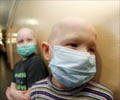School closures and other social distancing measures during the first wave were associated with a reduction in the H1N1 transmission rate.

Social distancing measures were enacted in Mexico where the pandemic affected different geographical areas of the country during three distinct waves. During the spring of 2009 when the virus affected the Mexico City area, officials choose to take measures to limit the virus' spread including cancelling large gatherings like soccer games.
New evidence suggests that these measures were effective, according to a new study led by ASU assistant professor Gerardo Chowell-Puente, an investigator for the Fogarty International Center at the National Institutes of Health and an assistant professor in the Arizona State University School of Human Evolution and Social Change in the College of Liberal Arts and Sciences.
The study provides the first comprehensive epidemiological description of the age, geographical and severity pattern of the 2009 pandemic in Mexico. Results of the study will be published in PloS Medicine.
"The interesting finding is that school closures and other social distancing measures during the first wave were associated with a reduction in the transmission rate by approximately 29 to 37 percent," Chowell said. "That is a significant change for a rapidly disseminating pandemic virus." Approximately 1,500 deaths were directly attributed to H1N1 flu in Mexico during 2009, he added.
In addition, hospitalization rates declined from about 70 percent to 10 percent during the period when schools closed and other social distancing measures enacted. Results of the study were calculated by applying mathematical modeling to influenza surveillance data compiled by the Mexican Institute for Social Security, a private health system representing 40 percent of the population.
Advertisement
More young people were affected by the H1N1 virus since older people had some immunity after a similar strain circulated years ago.
Advertisement
Researchers also examined how the virus spread spatially, identifying three H1N1 waves with the first cases primarily around the Mexico City metropolis in spring of 2009 and the second summer wave in southeastern Mexico. The third wave was more widespread throughout the country and coincided with the start of school during the fall.
Findings from the study have implications for improving preparedness plans in future pandemics, said Chowell, who noted that in a previous pandemic in the 19th century, the majority of deaths occurred two years after the initial wave.
"We must remain vigilant and continue to monitor the circulation and health burden of this flu virus in the coming years," he added.
Source-Eurekalert








